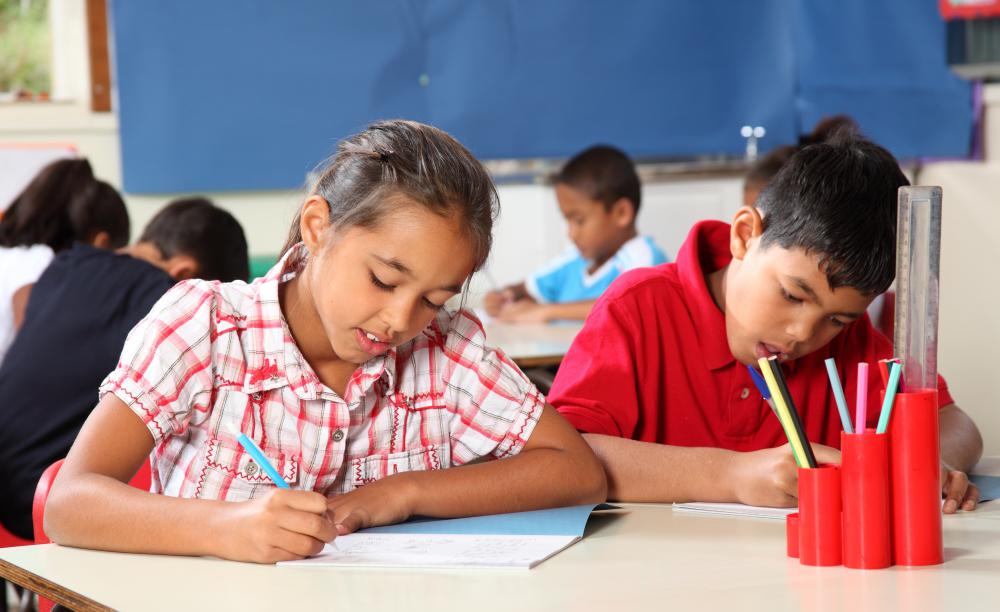At WiseGEEK, we're committed to delivering accurate, trustworthy information. Our expert-authored content is rigorously fact-checked and sourced from credible authorities. Discover how we uphold the highest standards in providing you with reliable knowledge.
What Are the Different Types of Literacy Lesson Plans?
Literacy lesson plans should be tailored to the age of the students. In early childhood, the focus is typically on learning to write, learning the letters and letter sounds, and learning to read. Once writing and reading has been mastered, literacy lesson plans for older children will shift to developing proper composition, reading comprehension, and improving vocabulary.
Children between the ages of three to five typically focus on learning to recognize the letters of the alphabet, letter sounds, strengthening the hand coordination needed for writing, and beginning to write the letters. At this age, lesson plans typically involve games and songs that provide repeated exposure to the letter names as well as repetition of the letter sounds. Children will eventually begin to learn to read, and lesson plans will involve learning to sound out words, memorizing sight words or words encountered over and over, and practicing to read simple books.

To strengthen the hand coordination needed for writing, lesson plans for children between three and five will also be centered on making art projects which require coloring, pasting, cutting, and manipulating materials. Lesson plans will also include listening to picture books read aloud in order to work on language assembly and reading comprehension. Learning to read and write can difficult and frustrating for young children, so lesson plans for this age group need to challenge and strengthen skills but not frustrate, and should be accompanied by frequent praise and positive feedback.

Literacy lesson plans for children between the ages of five and nine will focus on continuing to strengthen the ability to write the alphabet in upper and lower case letters and eventually introduce cursive writing. Lesson plans will also begin to work on composition by teaching simple grammar rules, writing style, and spelling. Reading skills and comprehension will be strengthened by providing more sophisticated and longer books. At this age, lesson plans will often aim to hone more than one skill at a time. For example, a lesson plan may involve having the children write books, poems, and letters, which will simultaneously strengthen their writing, practice correct sentence formation, and work on vocabulary and spelling.

Most children over the age nine will have basic writing and reading skills, so literacy lesson plans will shift to improving writing style, grammar, and vocabulary. Children at this age are typically taught different forms of writing, such as poetry, the standard business letter, and essays. Lesson plans will involve teaching research and fact gathering skills to add depth to the writing. In order to test reading comprehension and broaden their vocabulary, literacy lesson plans will also aim to expose older kids to varied and challenging books.
AS FEATURED ON:
AS FEATURED ON:














Discussion Comments
@Scrbblchick -- Yeah, I know what you mean. First graders have no social standing to worry about.
I've done some remedial classes for college freshmen (usually referred to as "bonehead English") and it's really sad how little some of these students have picked up over the years. As you said, there's a shame factor to overcome, plus all the bad habits and lack of good study habits. For college students, that may be the most important part of a literacy class: teaching good study habits. Some of these students never learned to study, so they just drifted through their classes and now find they don't know how to really buckle down in class.
These kids in remedial English can usually read, of course, but I've found their basic language skills to be sorely lacking -- usually because they just never had to learn the material.
I've taught adult literacy classes, and in some ways, those are the hardest ones to teach. With children, you're beginning with a blank slate and they don't have any preconceived notions about how difficult it might be to read and write. Plus, you don't have to overcome shame because they can't.
With adults, the shame factor is huge, and lessons have to be prepared and taught so that the adult is always encouraged and never feels the lessons are "talking down" to him or her. The student should always feel every lesson teaches something, and that progress has been made. It can be tough, but it's rewarding.
Post your comments